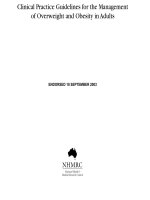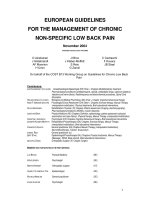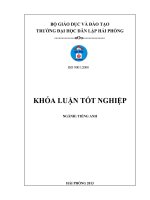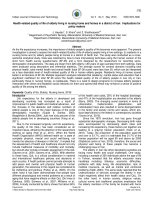FAST FACTS FOR THE CLINICAL NURSING INSTRUCTOR Clinical Teaching in a Nutshell pot
Bạn đang xem bản rút gọn của tài liệu. Xem và tải ngay bản đầy đủ của tài liệu tại đây (546.96 KB, 184 trang )
FAST FACTS FOR
THE CLINICAL NURSING
INSTRUCTOR
Clinical Teaching in a Nutshell
About the Authors
Eden Zabat Kan, DNSc, RN, received her bachelor’s degree in nurs-
ing from the Penn State University at State College, PA, her master’s
degree in nursing education from Villanova University, Villanova, PA,
and her doctorate in nursing science from Widener University,
Chester, PA. She is currently employed in the ICCU at Civista Med-
ical Center in LaPlata Maryland. Beginning Fall 2008, she will be
teaching undergraduate students at the School of Nursing at The
Catholic University of America in Washington DC. Prior to this posi-
tion, she was a member of the faculty at West Chester University’s
Department of Nursing, where she coordinated clinical and didactic
instruction for senior level undergraduate students. Her publications
have been in the areas of medical surgical nursing, cardiac surgery,
and nursing education.
Susan Stabler-Haas, MSN, RN, CS, LMFT, is an Assistant Professor
of Nursing at West Chester University, PA, where she has been a fac-
ulty member since 1996. She is a graduate of Villanova University and
has over twenty years of classroom and clinical teaching experience
in the areas of medical-surgical, critical care, geriatric, and psychiatric
nursing. Her instruction is influenced by her prior roles as staff nurse,
rehab nurse, and critical care nurse manager in five Philadelphia area
hospitals. She has educated students in a variety of nursing programs,
including diploma, associate, baccalaureate, RN to BSN, and second
degree nursing. Professor Stabler-Haas has also earned a Psychiatric
Clinical Nurse Specialist designation from the University of Pennsyl-
vania, and has been practicing as a licensed Marriage and Family
Therapist.
FAST FACTS FOR
THE CLINICAL NURSING
INSTRUCTOR
Clinical Teaching in a Nutshell
Eden Zabat Kan, DNSc, RN
Susan Stabler-Haas, MSN, RN, CS, LMFT
New York
Copyright © 2009 Springer Publishing Company, LLC
All rights reserved.
No part of this publication may be reproduced, stored in a retrieval system, or trans-
mitted in any form or by any means, electronic, mechanical, photocopying, record-
ing, or otherwise, without the prior permission of Springer Publishing Company, LLC.
Springer Publishing Company, LLC
11 West 42nd Street
New York, NY 10036
www.springerpub.com
Acquisitions Editor: Allan Graubard
Production Editor: Barbara A. Chernow
Cover design: Joanne E. Honigman
Composition: Agnew’s, Inc.
08 09 10 11/ 5 4 3 2 1
Library of Congress Cataloging-in-Publication Data
Kan, Eden Zabat.
Fast facts for the clinical nursing instructor : clinical teaching in a nutshell / Eden
Zabat Kan, Susan Stabler-Haas.
p. ; cm.
Includes bibliographical references and index.
ISBN 978-0-8261-1887-5
1. Nursing—Study and teaching. I. Stabler-Haas, Susan. II. Title.
[DNLM: 1. Education, Nursing—methods. 2. Clinical Medicine. 3. Teaching—
methods. WY 18 K1568s 2008]
RT71.K28 2008
610.73071′1—dc22
2008037752
Printed in the United States of America by Courier
The author and the publisher of this Work have made every effort to use sources be-
lieved to be reliable to provide information that is accurate and compatible with the
standards generally accepted at the time of publication. Because medical science is
continually advancing, our knowledge base continues to expand. Therefore, as new
information becomes available, changes in procedures become necessary. We recom-
mend that the reader always consult current research and specific institutional poli-
cies before performing any clinical procedure. The author and publisher shall not be
liable for any special, consequential, or exemplary damages resulting, in whole or in
part, from the readers’ use of, or reliance on, the information contained in this book.
The publisher has no responsibility for the persistence or accuracy of URLs for exter-
nal or third-party Internet Web sites referred to in this publication and does not guar-
antee that any content on such Web sites is, or will remain, accurate or appropriate.
Contents
Foreword ix
Preface xiii
Acknowledgments xv
Part I: Appreciating Your New Identity:
From Caregiver to Educator
1 Developing a New Identity as a Clinical
Nursing Instructor 3
2 Understand the Rules: What Every Nursing
Instructor Needs to Know about the
Nursing Program’s Policies 15
Part II: Your Success Depends on “You”:
Preparing for Your Clinical Teaching Assignment
3 You Are a Guest, So Act Like One 25
4 Organize the Semester – Have a Plan 31
5 Confidentiality and Patient Privacy 39
v
Part III: Getting To Know Your Nursing Students:
Who Are the Best, and Who Are the Rest?
6 The High Fliers: How to Screen for Higher
Achieving Students 47
7 The Not-So-High Fliers: How to Screen for
Potential “Problem Students” 51
Part IV: The Performance Appraisals:
Clinical Evaluations
8 Making the Most of Student Self-Evaluation 61
9 The DOs and DON’Ts of Student Documentation 67
10 Early Warning System 73
11 Graded Clinical vs. Pass/Fail Evaluations 81
Part V: Communication at Clinical Conferences
12 Preconferences 89
13 Postconferences 95
Part VI: The Art of Making a Clinical Assignment
14 Unplanned Events 103
15 Alternative Assignments 109
vi
CONTENTS
Part VII: Competencies Not Met
16 Punctuality and Absences 119
17 Unsafe Practice 125
18 What Your Students Will Expect from You 133
19 Conclusion 143
Appendix A 149
Appendix B 153
Appendix C 157
References 159
Index 161
CONTENTS
vii
This page intentionally left blank
Foreword
Each of us has significant memories of our nursing school ex-
perience. Maybe we remember the clinical instructor who
talked us through giving our first injection or inserting a Foley
catheter. Maybe we remember “shaking in our boots” for fear
that we would be unprepared to answer our instructor’s ques-
tions. Maybe we remember the instructor we could approach
with what we perceived to be a “stupid question.” It is hoped
that in all of these cases, we remember the importance of qual-
ity nursing and how much we learned from the instructors
who dedicated their lives to providing positive learning expe-
riences in the clinical setting. Although we might not be able
to acknowledge these positive feelings as nursing students, we
should come to appreciate the expertise of these faculty mem-
bers in the clinical setting and remember our goal to achieve
that same level of excellence.
The education of nursing students requires a balance be-
tween theoretical knowledge and clinical application—what
some refer to as the science and art of nursing. Many nursing
faculty members perform both of these roles within the nurs-
ing program, but as financial constraints increase, many col-
ix
leges and universities have hired adjunct faculty who work only
in the clinical facility with nursing students. Many of these in-
dividuals have significant clinical expertise, but they may lack
the knowledge and skill to convey that expertise to students.
Some faculty have not completed the graduate courses that
support the teaching role, such as Curriculum, Tests and Mea-
surements, Creative Teaching Strategies, and, most impor-
tantly, the Teaching Practicum experience, in which graduate
students are placed in colleges and universities for a semester
to learn the role of the nursing faculty member.
We all have to start somewhere, and I suspect some of you
can remember your first clinical teaching position. The best
clinical instructors make the job look easy, and most people
don’t realize how much effort goes into the process of clinical
teaching that creates a positive learning environment for the
nursing student. This book provides readers with a framework
of ideas that will help them prepare for clinical teaching, in-
cluding organizing the clinical experience, developing relation-
ships with the staff in the clinical facilities, making clinical
assignments, planning orientation days, developing clinical
rotations, planning and facilitating pre- and postconferences,
clinical evaluations, legal issues of clinical education and, of
course, handling the student who is in jeopardy of failing the
clinical course. The clinical instructor carries the additional
burden of accountability—ensuring that each student is pro-
viding safe and effective nursing care to the patients. As a re-
sult, issues of personal liability and techniques for handling
the student who is in jeopardy of giving unsafe care become
important. Picture yourself teaching eight to ten nursing stu-
dents on a busy medical surgical unit. If each student carries
x
FOREWORD
two to three patients, you quickly become aware of how chal-
lenging this responsibility can be. No wonder I have heard
more than a few graduate students during their teaching prac-
ticum experience express surprise when they say, “I never
knew how much work went into teaching!” I would be remiss
if I didn’t mention Teresa Christian as a shining example of
these clinical nursing instructors. Many Villanova University
alumni have described her as “tough, but the best instructor
I ever had!”
The idea for this book began with discussions over coffee
between two faculty members who had a similar philosophy
about clinical instruction. They shared a commitment to mak-
ing the clinical experience the best it could be for their stu-
dents, making improvements each year they taught. In addi-
tion, they were often assigned the task of orienting and
mentoring new clinical faculty. The authors agreed that what
was missing in the literature was a “real-life” practical guide
to assist new faculty in transitioning from clinical practice to
clinical education. From those early discussions and a lot of
brainstorming, this book became a reality.
This book serves as a valuable resource for nurses who are
beginning their professional teaching careers and for sea-
soned faculty who seek additional resources to improve the
clinical experience for their students. In many ways, this book
is a tribute to the clinical aspects of our nursing programs and
to the clinical faculty members who strive to make the student
experience a positive one. This book was written by two of
the best clinical faculty members I have ever known. I have
learned much from them in my own practice, and I am con-
fident that you will also grow from their combined experience
FOREWORD
xi
and wisdom. There is no question that you will find among
these pages a wealth of pragmatic, “real-life” information on
the clinical teaching process.
I want to thank Susan Stabler Haas and Eden Zabat Kan
for asking me to write the foreword for this book. It is indeed
an honor to be a small part of this significant contribution to
the nursing education literature. I am confident this book will
help you to become one of those clinical instructors that stu-
dents will look back on with pride and say, “That clinical in-
structor made me the nurse I am today!”
Susan C. Slaninka, EdD, RN
Adjunct Professor of Nursing
Villanova University College of Nursing
xii
FOREWORD
Preface
Let’s face it. Not every nurse would make a good clinical in-
structor. Technical proficiency alone does not guarantee the
ability to effectively manage nursing students at the clinical
site. Even nurses who are capable of providing clinical in-
struction may not wish to take on the considerable personal li-
ability associated with the oversight of these nursing students.
Perhaps you are different. Perhaps you are one of those
nurses who is in fact both capable and willing to impart your
knowledge to the next generation of caregivers. We commend
you, for the future of our profession rests on your shoulders.
After all, what is more important to the future of nursing than
supervising and sharing our expertise with future nurses?
While personally rewarding, this vital role is also a formi-
dable challenge. Clinical teaching is not easy. The expecta-
tions for an effective clinical nursing instructor are daunting.
It can be a prodigious undertaking even for individuals with
training or degrees in clinical instruction. They are continu-
ally faced with the changing demands of the patient and the
challenges of adapting instruction to different learning styles.
Moreover, most new clinical instructors do not have a solid
xiii
foundation in teaching clinical courses. Indeed, many may
not have any teaching experience. As a result, they face per-
formance insecurities, along with the daily teaching chal-
lenges. It is easy to understand why nursing programs are
pressed to fill their clinical instructor positions.
Our book, Fast Facts for the Clinical Instructor: Clinical
Teaching in a Nutshell, represents thirty-two years of combined
teaching experience. Designed as a practical guide for clinical
instructors, it uses an “easy-to-follow” format. Each chapter
provides information on key topics that should help ease the
transition for the novice clinical nursing instructor, as well as
provide alternate teaching approaches for the experienced in-
structor. Nuggets of pertinent information are summarized in
boxes that present “Fast Facts in a Nutshell.” The appendices
provide valuable and useful material for the novice instructor.
Instructors can preview templates that will assist them with
organizing an orientation day, a clinical student assignment,
and written assignments. In short, this book will help you, the
clinical nursing instructor, introduce your students to their
new career. It will provide guidance as you oversee their grad-
ual development into professional caregivers. Finally, we hope
that it provides the needed support and assistance you need
to effectively teach future nurses in their clinical courses.
<set following 2 lines flush right, line for line>
Eden Zabat Kan, DNSc, RN
Susan Stabler-Haas, MSN, RN, CS, LMFT
xiv
PREFACE
Acknowledgments
I am indebted to the many undergraduate and graduate stu-
dents I have encountered over the years. You have all inspired
me and are tied to my life forever. Thank you to all my friends
and colleagues at West Chester University for giving me the
support and friendship to become the teacher that I am
today. Thank you for helping me make a living doing some-
thing that I love so much. I especially enjoyed working with
Susan Slaninka. Thank you for taking my calls and sharing
your wisdom when I needed it. You are proof that effective and
successful teachers can also laugh and smile a lot. To my good
friend Susan, it is still hard for me to believe that our many
lunch or “after-clinical” chats about teaching in the clinical
setting has led to this wonderful outcome. Thank you for be-
ing a true partner with this writing endeavor. I cherish our
friendship. And finally to my wonderful husband, Dexter, I am
blessed to have found you.
<set following line flush right>
Eden Zabat Kan, DNSc, RN
xv
I wish to thank all of my students whose feedback over the
years has helped to shape this book. I also would like to thank
my husband, Joe. Special thanks to Chris, my son, and my
family and friends for all of their encouragement and support.
To my coauthor, Eden, no one could ask for a better coauthor.
Thanks to Susan Slaninka for all of her support over the years
and for writing the Foreword to our book.
Susan Stabler-Haas, MSN, RN, CS, LMFT
xvi
ACKNOWLEDGMENTS
Part I
Appreciating Your
New Identity
From Caregiver to Educator
This page intentionally left blank
Chapter 1
Developing a New Identity as
a Clinical Nursing Instructor
INTRODUCTION
Both the novice and the experienced nursing teacher need
to modify their mindsets on many occasions. They need to
shift their actions from the delivery of quality care of pa-
tients to the delivery of quality education to students who
will one day provide patient care. This chapter introduces
the “top ten” facts essential for clinical nursing instruction.
This chapter presents a questionnaire for your com-
pletion. After answering the questions, you will find ex-
planatory information designed to enhance the develop-
ment and refinement of your identity as a clinical nursing
instructor.
In this chapter, you will learn:
1. How to begin the transition from staff nurse to clinical
nursing instructor.
2. The basic facts of clinical teaching.
3
You have just begun a journey from staff nurse to clinical nurs-
ing instructor. Or, perhaps, you have been a nursing instruc-
tor who always felt the need for more information, more guid-
ance, and more specific examples and plans to successfully
instruct your students. Throughout this book, you will learn
concrete and useful information that you can use immediately
—even on the same day that you read it.
To begin, you should ask two questions:
1. What may be required for my transition from staff nurse
to nursing clinical instructor?
2. Which of the following facts do I feel are important?
QUESTIONNAIRE
Place a T for true or an F for false next to the following facts
below. Then, review the answers the that follow the ques-
tionnaire.
____
1. I will need to prove my clinical competency on a
daily basis.
____
2. I will contribute to the nursing profession.
____
3. I must be friends with my students.
____
4. My students must always like me.
____
5. The unit’s staff nurses and aides should be happy
to take guidance from me.
____
6. I want to be familiar with the unit and the staff be-
fore I bring my students to the clinical setting.
4
FAST FACTS FOR THE CLINICAL INSTRUCTOR
____
7. I must know every detail about every client that my
students care for.
____
8. I must supervise every procedure and almost all in-
teractions between my students and patients.
____
9. I will earn much more money in this position.
____
10. All of my students will be motivated to learn as
much as possible.
ANSWERS TO THE QUESTIONS: TRUE OR FALSE?
1. I will need to prove my clinical competency on a daily
basis.
Some of you are transitioning from practice as expert staff
nurses. Others are tenured professors, academic experts who
need additional guidance in supervising students and in
grasping the many facets of clinical instruction. Whatever
your background, the first item for a clinical instructor to re-
member is that you will have to supervise clinical experiences
with student nurses. The students you will encounter, whether
in a two- or four-year program, are novice learners. Learning
to refrain from performing any nursing skill or procedure for
the student learner will be a major challenge. If the student is
having a problem performing a basic clean dressing change on
a wound, for example, you may be tempted to take over and
complete the procedure. Resist taking over! Many seasoned
clinical instructors will tell you, “Think more like a teacher
and less like a nurse!” Your own professional goals of clinical
competence should be tempered. Keep in mind that your role
DEVELOPING A NEW IDENTITY
5
in the clinical setting is to enhance student learning by super-
vising (and not performing) skills. This involves using teach-
ing learning strategies to enable the student to perform the
clinical skill with knowledge and eventual competence.
An effective clinical instructor uses these strategies, such
as “questioning,” “role playing,” and “interactive discussion,”
to improve students’ thinking and problem solving skills. This
is not an easy task. Being a good teacher requires much prac-
tice and learning.
6
FAST FACTS FOR THE CLINICAL INSTRUCTOR
Fast facts in a nutshell
• Think more like a teacher and less like a nurse!
2. I will contribute to the nursing profession.
Many nurses become clinical instructors without realizing
that time is required to transition to the role. Part of the tran-
sition is learning the duties and values of that role. According
to the AACN (2001), clinical instructors have, at a minimum,
a practice focus and a commitment to decision making and
critical thinking pedagogy. The practice of clinical education
is highly valued in this current environment of nursing short-
ages. Whether you are a part-time or full time clinical instruc-
tor, you are contributing to a profession that is greatly in need
of successful instructors who can teach students how to ef-
fectively care for their patients.
3. I must be friends with my students.
If you go into clinical teaching thinking that you can be
“friends” with your students, then your tenure in this role will
be short. As a result of the combined objective and subjective
nature of clinical instruction and evaluation, friendships with
your students can lead to difficult situations, particularly dur-
ing the evaluation periods. Remember that each school’s cur-
riculum establishes many clinical objectives. If you share out-
side activities with students, you will expend energy that
should be focused elsewhere—energy that should be used to
enhance your students’ clinical competence. In the unfortu-
nate event that you may have to discipline or correct a student
under your tutelage, it will be more difficult if you have not
maintained the “boundary of teacher:student.” Keep personal
information about yourself to a minimum.
DEVELOPING A NEW IDENTITY
7
Fast facts in a nutshell
• The practice of clinical education is highly valued at
this current environment of nursing shortages.
Fast facts in a nutshell
• Maintain the boundary of teacher:student.
• Keep personal information out of the clinical setting.
4. My students must always like me.
Face it, we all want to be liked as teachers. However, you
should first focus on the clinical objectives for your students
and place less emphasis on whether students “like” or even
“appreciate” your efforts. Wouldn’t you rather be the teacher
who instills a memorable learning experience? Focus instead
on the “aha” moments of your students—moments when
your clinical thinking questions led to further student inquiry
and successful application of concepts! Once you experience
this moment, you will be hooked on teaching. You will realize
that friendships and being “liked” cannot replace this feeling
of accomplishment.
8
FAST FACTS FOR THE CLINICAL INSTRUCTOR
Fast facts in a nutshell
• Wait for the “aha” moments!
5. The unit’s staff nurses and aides should be happy to
take guidance from me.
Staff personnel, nurses, and aides are familiar with required
routines at their clinical agencies and are knowledgeable about
their work. Although they are not happy about changes in
policy or procedures, they will adapt in time. Thus, they will
eventually accept you and your students and be willing to al-
ter their routines a bit. However, they will not be receptive to
verbal direction or recommendations from a clinical instruc-









